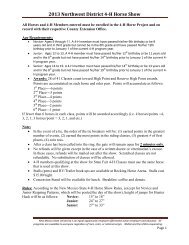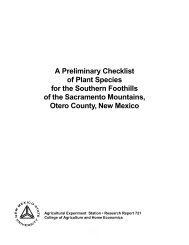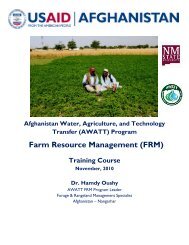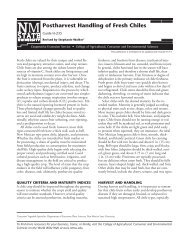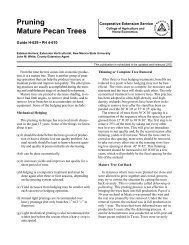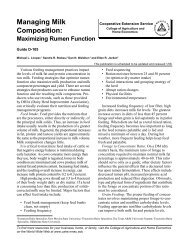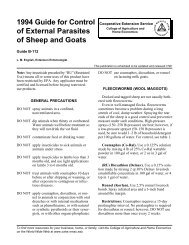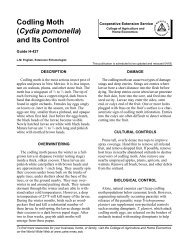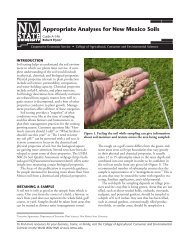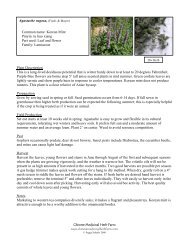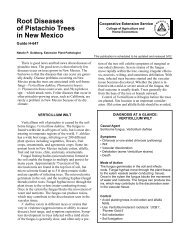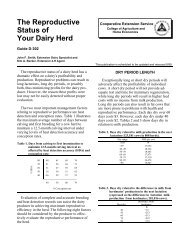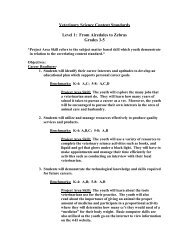Proper Semen Handling Improves Conception Rates of Dairy Cows
Proper Semen Handling Improves Conception Rates of Dairy Cows
Proper Semen Handling Improves Conception Rates of Dairy Cows
You also want an ePaper? Increase the reach of your titles
YUMPU automatically turns print PDFs into web optimized ePapers that Google loves.
<strong>Proper</strong> <strong>Semen</strong> <strong>Handling</strong><strong>Improves</strong> <strong>Conception</strong><strong>Rates</strong> <strong>of</strong> <strong>Dairy</strong> <strong>Cows</strong>Cooperative Extension ServiceCollege <strong>of</strong> Agriculture andHome EconomicsN EW MEXU NICOSTAEI V E R SI T YTGuide D-303Michael Looper, Extension <strong>Dairy</strong> SpecialistArtificial insemination (AI) has greatly enhancedproduction potential in the dairy industrysince its implementation in the United States inthe late 1930s (Cole, 1938). However, impropersemen handling can result in low conceptionrates, minimizing the advantages <strong>of</strong> an AI program.<strong>Semen</strong> is most frequently damaged duringhandling after thawing and prior to insemination<strong>of</strong> the cow. The following practices should helpminimize semen damage that occurs due to improperhandling procedures.Caring for Insemination EquipmentSeveral items are necessary to perform successfulartificial insemination, including an AIgun, plastic sheaths, shoulder-length gloves,straw cutter, thermometer, thaw box, tweezers,paper towels, and lubricant. Plastic or stainlesssteel boxes are good containers in which to keepequipment clean and dry. Clean equipment aftereach use with 70 percent isopropyl alcohol to preventspread <strong>of</strong> disease. Disinfectants and soapsThis publication is scheduled to be updated and reissued 9/05.are lethal to semen and should not be used as lubricantsor to clean equipment.Removing <strong>Semen</strong> fromthe Liquid Nitrogen TankTime spent removing semen from the liquidnitrogen (LN) tank must be kept to a minimum toreduce semen damage. Temperatures can reach+54°F in the neck <strong>of</strong> the LN tank (1 inch from thetop) (Saacke, 1974; fig. 1). If the entire canister<strong>of</strong> semen (10 straws) is withdrawn above the frostline (2 to 3 inches from the top <strong>of</strong> the tank), allstraws <strong>of</strong> semen can be damaged. When the desiredstraw <strong>of</strong> semen cannot be located within 10seconds <strong>of</strong> raising the canister, lower the canisterback into the LN for 10 to 15 seconds to coolcompletely. Remove semen from the tank withtweezers, not with the hands. Note the location <strong>of</strong>the semen in the tank before removing the plugfrom the tank. This can be accomplished bymaintaining a tank inventory with a wall chart orinventory wheel (fig. 2). Quantity <strong>of</strong> semen re-123456+ 54 o to + 36 o+5 o to - 8 o- 40 o to -51 o-103 o to -116 o 6"-148 o to -184 o-220 o to -256 o-292 o to -313 <strong>of</strong>rost linevaccum andfiberglass insulationouter tankinner liner-320 oliquid nitrogenFigure 1. Temperatures found in the neck <strong>of</strong> a semen tank. Adapted from Saacke, 1974.To find more resources for your business, home, or family, visit the College <strong>of</strong> Agriculture and Home Economicson the World Wide Web at www.cahe.nmsu.edu
6Sire Q 0 0 0 0 0Sire R 0 0 0 0 0 0 0 0 0 0Sire S 0 0 0 0 01Sire A 0 0 0 0 0 0 0 0 0 0Sire B 0 0 0 0 0 0 0 0 0 0Sire C 0 0 0 0 0 0 0 0 0 05Sire D 0 0 0 0 0 0 0 0 0 0Sire E 0 0 0 0 0 0 0 0 0 0Sire F 0 0 0 0 0 0 0 0 0 0notes/comments2Sire K 0 0 0 0 0 0 0 0 0 0Sire L 0 0 0 0 0 0 0 0 0 0Sire M 0 0 0 0 0Sire N 0 0 0 0 0Sire P 0 0 0 0 04Sire G 0 0 0 0 0Sire H 0 0 0 0 0 0 0 0 0 0Sire I 0 0 0 0 0Sire J 0 0 0 0 0 0 0 0 0 03Figure 2. <strong>Semen</strong> inventory wheel made from Plexiglas or laminated cardboard. Sire number can be written on adhesivelabels and attached to the wheel or written directly on the wheel with erasable markers. Circles representstraws <strong>of</strong> semen and can be darkened after each straw is used (adapted from Senger, 1992).maining in the LN tank also can be accounted forwith such a system.Thawing <strong>Semen</strong>Unfortunately, recommended procedures forthawing semen are not the same for all AI companies.<strong>Dairy</strong> producers usually use semen fromseveral companies but use only one protocol forthawing semen. The National Association <strong>of</strong> AnimalBreeders (NAAB) recommends thawing semenat about 90° to 95°F for at least 40 seconds(Herman and Madden, 1987). Thawing semen betweenthese temperatures allows more semen tosurvive the thawing process. Calibrate the thermometersused for monitoring thaw water temperatureon a regular basis to insure accuracy <strong>of</strong>temperature measurements. Never thaw semenstraws in your pocket or in the cow. Under theseconditions, thaw rates are too slow and will reducethe number <strong>of</strong> viable sperm cells. Completelydry the semen straw with a paper towelafter thawing because water is lethal to sperm cells.In large herds, it is not uncommon for severalcows to exhibit estrus on the same day, so it islikely that numerous straws <strong>of</strong> semen will bethawed at one time. Researchers at WashingtonState University (Brown et al., 1991) reportedthat as many as 15 to 20 straws <strong>of</strong> semen can bethawed simultaneously in a thermos without reducingsemen quality (fig. 3). However, the innersemen straws <strong>of</strong> a group <strong>of</strong> straws that had frozentogether demonstrated reduced motility, suggestingthe thaw water should be agitated so thatstraws do not freeze together during thawing. Alarger volume <strong>of</strong> water (more than 1 quart) is recommendedif more than five straws <strong>of</strong> semen arethawed simultaneously (DeJarnette, 1999). Thenumber <strong>of</strong> straws <strong>of</strong> semen thawed should not exceedthe quantity that can be used within 10 to 15 minutes.Guide D-303 • Page 2
6050Zero hour evaluation40302010Percentage motility02 5 10 15 20 overall605040Four hour evaluationNonthermostatically controlledThermostatically controlled30201002 5 10 15 20 overallNumber <strong>of</strong> straws thawed simultaneouslyFigure 3. Effect <strong>of</strong> thawing groups <strong>of</strong> straws and type <strong>of</strong> thawing bath on percentage <strong>of</strong> sperm motility 0 hoursand 4 hours after thawing at 97°F. Thawing semen in groups did not significantly damage sperm cells (adaptedfrom Brown et al., 1991).Loading the AI GunBefore loading the semen in the AI gun, warmthe gun by rubbing it with a paper towel to avoidcold-shocking the semen (ABS Global, 1996).Cut the semen straw at the crimped end, not atthe end with the cotton plug. Then place a plasticsheath over the semen and gun. Place the semengun close to your body under clothing (such as ashirt or jacket) to avoid cold-shocking semen.A preliminary study from Hawaii (Lee et al.,1997) indicates loading multiple AI guns may bedetrimental to conception rates in hot environments.In this study, four cows were bred inabout 6 minutes. <strong>Cows</strong> bred last (at 6 minutes)had lower conception rates than cows bred first,second, and third (fig. 4). It should be noted thatthese conception rates were not statistically different.Further research with more cows is neededto confirm effects on conception rates <strong>of</strong> timefrom thawing to insemination. It still is recommendedthat cows be inseminated as soon as possibleafter thawing semen.<strong>Proper</strong> <strong>Semen</strong> <strong>Handling</strong> onLarge <strong>Dairy</strong> OperationsOn large operations, dairy personnel not acquaintedwith AI techniques sometimes are recruited tohelp inseminate cows. But only people who havebeen adequately trained in artificial inseminationshould be allowed to breed cows. Untrained personnelcan become fatigued, reducing the accuracy<strong>of</strong> semen deposition.General recommendations include thawing semenat 95°F in a water bath, not in the pocket orcow, for at least 30 seconds but not more than 15minutes. If several straws <strong>of</strong> semen are thawed atGuide D-303 • Page 3
5048%4041%38%<strong>Conception</strong> rate (%)3025%201001st 2nd 3rd 4thOrder <strong>of</strong> inseminationFigure 4. <strong>Conception</strong> rates <strong>of</strong> cows decrease with order <strong>of</strong> insemination (Lee et al., 1997).one time, stir the water bath so that straws do notfreeze together. Use the same caution when thawingseveral straws <strong>of</strong> semen as you would whenthawing a single straw.Do not load too many AI guns simultaneously.<strong>Conception</strong> rates could be reduced.Inseminate cows as soon as possible after semenis thawed. Dairies using lock-up stanchionsshould develop some form <strong>of</strong> an AI cart orwagon. A golf cart or other small vehicle (such asa mail truck) can be used to transport the AIequipment to the cow. This will allow less timebetween removing the semen from the thaw bathand inseminating the cow.Artificial insemination techniques <strong>of</strong> peopleresponsible for breeding cows should be reevaluatedon a regular basis (such as monthly or quarterly).It is important to remember that proper AItechniques must not be compromised for convenience.LITERATURE CITEDABS Global. 1996. A.I. Management Manual. ABSGlobal, Inc. (ed.). DeForest, WI.Brown, D.W., Jr., P.L. Senger, and W.C. Becker.1991. Effect <strong>of</strong> group thawing on post-thaw viability<strong>of</strong> bovine spermatozoa packaged in .5-milliliterFrench straws. J. Anim. Sci. 69:2303-2309.Cole, C.L. 1938. Artificial insemination <strong>of</strong> dairycattle. J. <strong>Dairy</strong> Sci. 21:131-132. (Abstr.).DeJarnette, M. 1999. How many straws should youthaw at once? Select Sires Selections. pp. 8-9.Herman, H.A., and F.W. Madden. 1987. The ArtificialInsemination and Embryo Transfer <strong>of</strong> <strong>Dairy</strong>and Beef Cattle (7 th ed.). Interstate Printers andPublishers, Inc., Danville, IL.Lee, C.N., T.Z. Huang, and A.B. Sagayaga. 1997.<strong>Conception</strong> rate in dairy cattle is affected by thenumber <strong>of</strong> semen straws thawed for breeding. J.<strong>Dairy</strong> Sci. 80 (Suppl 1): 151.Saacke, R.G. 1974. Concepts in semen packaging anduse. Proc. Eighth NAAB Conf. on Artif. Insem.Beef Cattle. pp.11-19.Senger, P.L. 1992. <strong>Handling</strong> frozen semen. In: H.H.Van Horn and C.J. Wilcox (eds.). Large <strong>Dairy</strong>Herd Management. pp. 110-115. American <strong>Dairy</strong>Science Association, Champaign, IL.New Mexico State University is an equal opportunity/affirmative action employer and educator. NMSU and the U.S. Department<strong>of</strong> Agriculture cooperating.September 2000Guide D-303 • Page 4Las Cruces, NM5C



